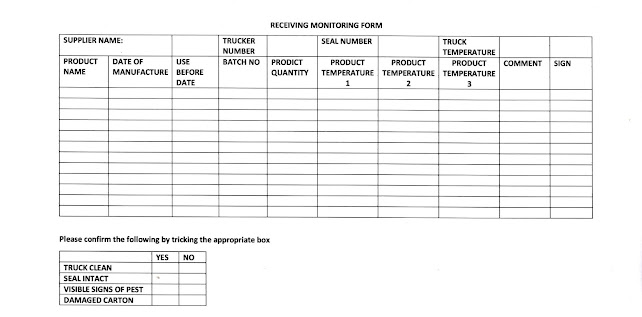Search This Blog
This blog is designed to help those who would like to set up a working HACCP Program for a warehouse.
Featured
- Get link
- X
- Other Apps
Receiving procedure for Food Warehouses
Keywords
Certificate
of conformity
A
document issued by a supplier showing that the supplied products meet a
specific criterion
Non-conforming
record
A
form in which details of products that don’t conform to quality standards are
recorded for traceability.
Non-conforming
area
A designated place in the storage area in which non-conforming goods are separated from the rest of the products while awaiting final disposition.
Receiving
Procedure
It is perhaps the most important of all warehouse activities. If
done wrong, it doesn't matter how well-handled other activities are - the
output will be non-conforming products. To explain this better, I will borrow a
computing phrase "garbage in, garbage out."
There are several quality checks carried out at the receiving stage, and these include; delivery truck inspection, food product inspection, and receiving area inspection. Remember, all these quality inspections target possible hazards identified during the hazard analysis in the HACCP Program.
The
delivery truck inspection;
Inspect the seal integrity for any form of tampering because it is proof
that the product has not been tampered with during transportation, and it is
safe from any form of sabotage.
A designated receiving personnel inspects the delivery truck for general cleanliness: looking out for visible dirt, pests, offensive odors, and any other possible contaminants that could pose a risk to the food product. In the case of temperature-sensitive products (chilled and frozen products), the delivery truck temperature is checked as well (from the temperature readout) for conformity to the set receiving standard as laid out in the HACCP program.
The
product inspection
Temperature-sensitive
products
The product temperature is measured using a clean
and sanitized calibrated thermometer. I advise using a probe thermometer as
opposed to the infra-red thermometer. The reason is simple- Infra-red
thermometer only measures surface temperature, yet the probe thermometer
measures the product's internal temperature, which gives a better understanding
of the temperature status of the products. However, when using a probe
thermometer, care should be taken not to pierce a product packaging as this can
be a source of contamination. The probe is placed between two primary packages
when taking the product temperature.
For a representative temperature status of the
product, the readings are taken repetitively during offloading. For a better
insight into the temperature of a particular product, pick samples from the
front, middle, and back of the product compartment.
For
delivery trucks with temperature monitoring devices, the data is downloaded and
checked to see if the product has been in a specified temperature range during
transportation.
Inspect the product cartons for sufficient expiry
date, proper labeling, and any damage sustained during transportation. Damaged
goods are non-conformed or put on hold for further inspections by designated
quality personnel.
A properly labeled product conforms to the following;
- Ingredients contained in the product.
- Health risks associated with the product.
- Storage instructions.
- Use by date
(expiry date).
Note; These are not
standard requirements for a product label, they can change depending on regulatory,
statutory laws, or client's needs.
The products must have an accompanying Certificate of Conformance
(COC) or Certificate of Analysis (COA) from the supplier. This certification is
evidence that the supplier followed all the statutory and regulatory rules
during the production of the product.
If
the food product deviates from any of the above criteria, it is labeled as a
non-conforming product and transferred to a designated storage area that meets
its storage instructions - Put chilled products in the chiller's non-conforming
area, and frozen non-conforming products into the non-conforming area in a
freezer. Record all non-conforming product details in a non-conforming form.
Please
note:
- The product should not have signs of prior
temperature abuse or signs of thawing and refreezing such as big ice
crystals in or on the product.
- The product temperature range is given by a regulatory body, a statutory body, or a client. But generally-chilling products are kept at 1°C-4°C and frozen products at -18°C (max < -12° C).
To know more about how to calibrate thermometer, check out this useful
resource; how-use-and-calibrate-probe-thermometer.
Dry
products and packaging material
Just like temperature-sensitive products, a dry product consignment must have a certificate of analysis or certificate of conformance. Check the dry products for sufficient expiry, damaged goods, proper labeling, and other contaminants that could make the product unsafe for consumption. Record all product details in the receiving form, and for the non-conforming products, their details are recorded in the non-conforming record.
Receiving
area
In the case of temperature-sensitive products, the receiving activities are carried out in a temperature control dock maintained at 1°C-7°C for not over one hour, but the warehouse management can choose a stricter temperature and time range.
Receiving
personnel
Designated receiving personnel must be knowledgeable about the
different receiving inspection, corrective actions in case of a deviation, and
the non-conformance procedure. The receiving personnel should be conversant
with documentation or record forms used in the receiving process.
Documents
used
Receiving
Monitoring Form
Goods
Received Note
Certificate
of Conformity/ Certificate of Analysis
Non-conforming
form/record
Note: The receiving stage can be a Critical Control Point or a Critical Point depends on the individual company's Risk Assessment.
Check Appendix 1 and Appendix 2 for samples of
Receiving Monitoring Form and Goods Received Note, respectively.
Appendix 1
Appendix 2
or reload the browser
or reload the browser
or reload the browser
or reload the browser
or reload the browser
or reload the browser
or reload the browser
- Get link
- X
- Other Apps
Popular Posts
HACCP Program for Warehouse Handling Food Products- A simple Guide for Startups
- Get link
- X
- Other Apps


.png)

Comments
Post a Comment